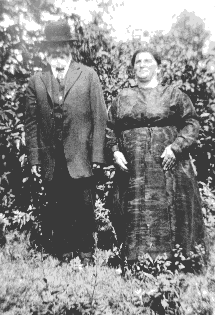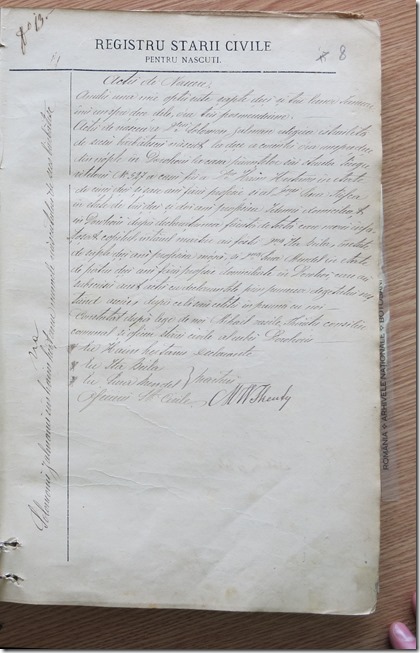I’ve put up more than 1200 blog posts since 2002, but I have never up to now posted a biography about anyone in my family tree. I thought today would be a good day to start.
Zalmon Hertzan was a younger brother of my great grandmother Toba Focsaner. He was born on Jan 10, 1873, so today would have been his 150th birthday. He never married and had no children so he has no direct descendants to remember him. I thought Zalmon was worth of remembrance so here is his story.
Born in Dorohoi, Romania in 1873
Zalmon was born in the Dorohoi, Romania. This is his birth record which is a really beautiful document as every birth record was handwritten and given a page of its own:
Here’s the translation:
(Dorohoi) 13/1873:
Birth Record of Solomon Zalman Hertzanu.
Registration Date: 11 Jan 1873, 3:00 PMDetails:
Gender: Male
Religion: JewishBirth Details:
Birth Date: 10 Jan 1873, 11:00 PM
Address: Dorohoi, parents’ house on 527 Targu Vitelor str.Parents:|
Father: Haim Hertzanu, 56, no profession
Mother: Sura Rifca, 32, no professionResidence: Dorohoi
Witnesses:
Declarent: the father who presented the child.
Witness1: Ita Beila, 70, midwife
Witness2: Sura Mendel, 40, no profession
I find it very interesting that his birth record lists him as Solomon Zalman. Solomon in Hebrew is Shlomo. Solomon In Yiddish is Zalmon. Yiddish would have been his family’s native language and the language he spoke in the home. I’m sure he learned Romanian as well and once he came to Canada, enough English to get by.
He was usually known as Zalmon throughout his life, although he was sometimes referred to as Shlomo. Solomon is the English translation of both those names. I found Solomon on some Canadian documents, and he may have used that name officially in Canada.
Zalmon’s parents were Haim (pronounced with a gutteral H (as in “Khaim”) and Sura Rivka. Haim’s profession in other records was listed as “merchant”.
Zalmon was the youngest of 8 known siblings, the others being:
- a sister Risel, born 1849
- a brother Aron, born 1853
- a sister Dvoira Servu, born 1856
- a sister Sheiva, born 1863
- a sister Toba, born 1864, my great grandmother
- a brother Shaia born 1868 who died 1874 age 6 before Zalmon was born
- a brother Louis, born 1870
The age of Zalmon’s mother on his birth record is likely wrong. She was listed as 39 years old on Shaia’s birth record, and 42 years old on Louis’ birth record indicating Sura Rifca was likely born in 1828 so she would have been about 45 when Zalmon was born, not 32.
Zalmon’s father’s age on his birth record was also likely a bit off, with other records indicating Haim was likely born about 1820, so he would have been 53 when Zalmon was born, not 56.
Life in Dorohoi, Romania
Dorohoi is a city in the Botoșani county in northern Romania currently with about 23,000 people. It had about 6,000 people in 1860 growing to 12,000 by 1900. Jews began to settle there in the 17th century. In 1860, half the population was Jewish. By 1900, more than half were Jewish and there were 20 synagogues in the city.
Zalmon’s birth record says he was born at home which was 527 Targu Vitelor street. There is no such street in Dorohoi today. Targu Vitelor in Romanian means Cattle Fair/Market, so it could have been the street where the market was located at the time.
Zalmon’s father Haim died in 1883 at the age of 63 when Zalmon was 10.
Zalman’s older sister Toba was my great grandmother. Toba married my great grandfather Joseph Focshaner in 1888.
Leaving the Country
Nothing in the history of Dorohoi indicates anything really bad happened to the Jews there in the 1880s and 1890s. But from 1899 to 1903, a series of pogroms spread from Romania to Bessarabia.
In April 1902, Joseph and Toba and their 5 children aged from 1 to 11 emigrated to Canada. Zalmon who was 29 at the time went with them. They somehow made their way across Europe from Dorohoi, Romania to Hamburg, Germany. Then they sailed to Halifax aboard the SS Bulgaria with almost 1800 other immigrants, of which 150 were bound for their same destination: Qu’Appelle.
From Halifax, they would have travelled 4,000 km (2,400 miles) across Canada by train to Qu’Appelle, which was about 50 km (30 miles) south of where their homestead was to be.
They were part of a second group of Jews from Romania. An earlier group arrived in 1901 and a 3rd group arrived later in 1902. In total, about 350 Jewish immigrants from Romania arrived and settled in this colony in those 2 years.
New Roots in Saskatchewan
Canada was among the many countries that offered a new home to those who sought relief and a new beginning. The Canadian government passed an act seeking to attract settlers to the Territories which allowed them later (in1905) to become the provinces of Saskatchewan and Alberta. Any male over 21 years of age, or a female who was the sole support of a family could register for a homestead of a quarter section (160 acres), a section was one square mile. By building a home, occupying the land for three years, and cultivating 30 acres, the title to the land could be obtained for a registration fee of just ten dollars.
Both Joseph and Zalmon obtained a quarter section next to each other in the rural municipality of Tullymet which was just East of the municipality and town of Lipton. The combined area was known as the Lipton Jewish Colony.
Joseph obtained NW 34 23-12-W2
Zalmon obtained SW 34 23-12-W2
The map above shows those residing in 1906 on sections 1 to 36 of 23-12-W2.
After overcoming the shock of a new country, they had to build a home out of logs on their land before the severe prairie winters were upon them. Then they began cultivating the land and acquiring livestock, including horses, cows and chickens.
The 1906 Census lists “Zerlman Hargani” age 27 (actually 33) living with Joseph and “Ioba” and their six children aged 3 to 18.
The 1911 Census lists “Sohrisu Hertsion” age 39 (actually 38) still living with Joseph and Toba and their six children aged 7 to 22.
The 1916 Census lists “Zalaman Hartzan” age 40 (actually 43) still with Joseph, Toba and their six children now aged 11 to 25.
The 1921 Census lists “Zalman Hartson” age 40 (actually 48) with Joseph, Toba and four of their children aged 16 to 25. The two eldest children were now married and living nearby.
Zalmon’s sister Toba died in 1923.
In 1924, Zalmon’s niece (my grandmother) Goldie’s husband died, and she and her 4 children moved back in with Joseph.
The 1926 Census lists “Solomon Hartson” age 45 (actually 53) with “Joe”, Joseph’s three unmarried children aged 21 to 24, Goldie aged 35 and Goldie’s four children aged 1 to 6.
We thus have documented Zalmon and his sister’s family living together, farming their combined 360 acres of land together, and enjoying life together for over 20 years.
Joseph died in 1927. His other children married soon after, and Goldie remarried and they all left the farm.
Photo
I do not have a photograph of Zalmon and don’t know what he looks like. I do hope I find one someday.
Here is a picture of his sister Toba and brother-in-law Joseph, circa 1920:

The Later Years
I don’t know what Zalmon did after the family left. A farm is too much for a single person to handle alone. A family is required. The family had over the years acquired Section 28 which was just southwest of the half-section 34 that they were given in 1902, and at least one of Zalmon’s niece’s was there with their husbands and children. So Zalmon was not alone and likely stayed and helped farm.
The 1930s were not an easy time to be on the farm. There was the depression and the drought years. Many of Joseph and Toba’s children, like other farmers, left the farm and moved to the big city of Winnipeg to start anew. One daughter Dora and her husband Abraham Elfenbaum and his family remained longer.
Zalmon worked as a farm laborer until September 1939. At that point, Zalmon may have moved to the Elfenbaum farm to live with his niece and her family. He died on May 8, 1944 at the Elfenbaum farm.
Zalmon was buried in the Bnay Abraham Cemetery just north of Winnipeg, where many of his nieces and nephews and cousins are buried. I personally visit Zalmon and the rest of the family at least once a year.
Zalmon was known to everyone in the family as Uncle Zalmon. His gravestone is inscribed with “In Loving Memory of our Dear Uncle Zalmon Hertzan”. His gravestone incorrectly says he was 60 years old, but he was born in 1873, so he was actually 71 years old. In Hebrew it says: Zalmon son of Haim Hertzan
I never met Zalmon because he died before I was born. But I hope this little story has brought him back to life a little.
Happy birthday Uncle Zalmon.
Sources
- Birth record of Solomon Zalman Hertzan, in Dorohoi, Romania, 1873, acquired by Louis Kessler from researcher Sorin Goldenberg in 2017. Translation by Sorin Goldenberg
- "Canada, Arriving Passengers Lists, 1865-1935," database with images, Ancestry, entry for Saloman Hartmann, 1902; Halifax, Nova Scotia, 1902, April, citing Passenger Lists, 1865–1935. Microfilm Publications T-479 to T-520, T-4689 to T-4874, T-14700 to T-14938, C-4511 to C-4542. Library and Archives Canada, n.d, .
- Death record of Zalman Hartzan, recorded in the Province of Manitoba, 1944, acquired by Louis Kessler from the Manitoba Department of Vital Statistics.
- Photo of gravestone of Zalman Hertzan, taken by Louis Kessler
- Iancu, Carol. 2010, Dorohoi, article from the YIVO Encyclopedia of Jews in Eastern Europe, https://yivoencyclopedia.org/article.aspx/Dorohoi
- Geni- Jewish Families of Dorohoi, Romania Project, https://www.geni.com/projects/Jewish-Families-of-Dorohoi-Romania/25415
- Theodore H. Friedgut, 2007, Jewish Pioneers on Canada’s Prairies: The Lipton Jewish Agricultural Colony, 1901 – 1951. Monograph: https://www.jhcwc.org/wp-content/uploads/2020/02/Friedgut.pdf. Full article at: https://www.jstor.org/stable/20728556
- Sol Sinclair, “Memories of Early Jewish Settlement at Lipton, Saskatchewan,” in Marjorie Drever, ed., Trails and Tales of Settlement and Progress, Lipton and District, 1875-1985. (Regina, 1987), 37.




